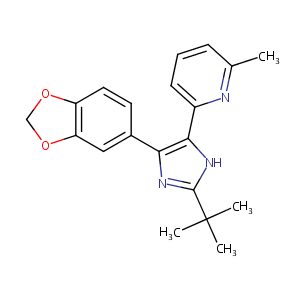Details of the Drug Combinations
General Information of This Drug (ID: DM4G09S)
| Drug Name | |||||||||||||||||||||||
|---|---|---|---|---|---|---|---|---|---|---|---|---|---|---|---|---|---|---|---|---|---|---|---|
| Synonyms |
SB-505124; 694433-59-5; SB505124; SB 505124; 2-(4-(benzo[d][1,3]dioxol-5-yl)-2-tert-butyl-1H-imidazol-5-yl)-6-methylpyridine; CHEMBL226838; 2-[4-(1,3-Benzodioxol-5-yl)-2-(tert-butyl)-1H-imidazol-5-yl]-6-methylpyridine; 2-[5-(1,3-Benzodioxol-5-yl)-2-(1,1-dimethylethyl)-1H-imidazol-4-yl]-6-methylpyridine; 2-[4-(2H-1,3-benzodioxol-5-yl)-2-tert-butyl-1H-imidazol-5-yl]-6-methylpyridine; MLS006010969; SCHEMBL373422; GTPL6049; CTK8E3615; KS-00000XPS; EX-A217; DTXSID50431926; AOB1766; AOB5688; MolPort-021-804-897; CHEBI:100922
|
||||||||||||||||||||||
| Indication |
|
||||||||||||||||||||||
| Drug Type |
Small molecular drug
|
||||||||||||||||||||||
| Structure |
 |
||||||||||||||||||||||
| 3D MOL | 2D MOL | ||||||||||||||||||||||
List of Combinatorial Drugs (CBD) Containing This Drug
|
4 Investigative Drug Combination(s) Consisting of This drug
Normalized Drug Combination Synergy Score
Synergy scores were normalized using Min-Max Scaling to facilitate visual comparisons.
|
||||||||||||||||||||||||||||||||||||||||
References
